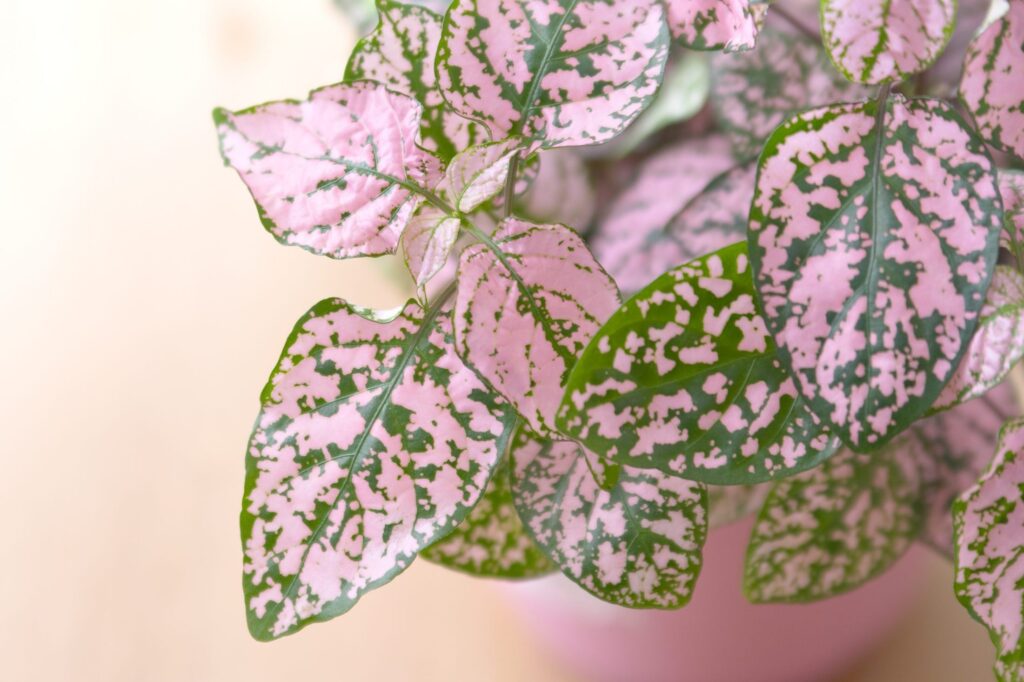
Introduction
In the world of gardening and horticulture, plants with pink and green leaves hold a special allure, captivating the eye with their striking foliage colors and patterns. Whether grown indoors or outdoors, these plants add a vibrant pop of color and visual interest to any space, enhancing the beauty of gardens, landscapes, and interior environments. In this article, we’ll explore some popular plant species with pink and green leaves, delving into their descriptions, cultivation requirements, and maintenance tips to help you incorporate these stunning specimens into your plant collection.
Pink Princess Philodendron
Description and Characteristics
Pink Princess Philodendron, scientifically known as Philodendron erubescens ‘Pink Princess,’ is a stunning cultivar prized for its variegated foliage adorned with shades of pink and green. The heart-shaped leaves feature pink splashes, stripes, or blotches against a backdrop of dark green, creating a captivating contrast. This climbing vine exhibits an epiphytic growth habit, producing aerial roots that allow it to attach to and climb up vertical surfaces such as tree trunks or moss poles.
Cultivation and Care
To thrive, Pink Princess Philodendron requires bright, indirect light, although it can tolerate lower light conditions. Keep the plant in a warm, humid environment with temperatures between 65°F to 80°F (18°C to 27°C) and avoid exposure to cold drafts or direct sunlight, which can scorch the delicate foliage. Plant in well-draining potting mix and water moderately, allowing the top inch of soil to dry out between waterings. Feed the plant monthly during the growing season with a balanced liquid fertilizer diluted to half strength.
Tips for Propagation and Maintenance
Propagation of Pink Princess Philodendron can be achieved through stem cuttings or air layering. Take stem cuttings with at least one node and aerial root, and root them in water or moist potting mix until new roots develop. Alternatively, encourage air roots to form by wrapping a section of stem with sphagnum moss and plastic wrap until roots emerge. Prune the plant as needed to maintain its shape and remove any leggy or discolored growth. Monitor for pests such as spider mites or mealybugs and treat promptly if detected.
Caladium ‘Pink Beauty’
Description and Characteristics
Caladium ‘Pink Beauty’ is a charming cultivar renowned for its heart-shaped leaves adorned with delicate pink veining. The leaves exhibit a vibrant mix of pink, green, and white hues, creating a mesmerizing tapestry of colors. This compact plant boasts a bushy growth habit, making it an ideal choice for adding pops of color to shady garden beds, borders, or container gardens. Caladium ‘Pink Beauty’ thrives in warm, humid environments and is often grown as a houseplant or summer annual in cooler climates.
Growing Conditions and Requirements
Caladium ‘Pink Beauty’ prefers partial to full shade and well-draining soil rich in organic matter. Plant the tubers with the eyes facing up and cover them with a few inches of soil, keeping them evenly moist but not waterlogged. Maintain high humidity levels around the plant by misting regularly or placing a tray of pebbles filled with water beneath the pot. Protect the plant from direct sunlight, as excessive sun exposure can scorch the delicate foliage and cause leaf burn.
Care and Maintenance
To care for Caladium ‘Pink Beauty,’ provide regular watering to keep the soil consistently moist but not soggy. Mulch around the base of the plant to retain moisture and suppress weeds. Fertilize the plant every 4-6 weeks during the growing season with a balanced liquid fertilizer diluted to half strength. Remove any yellowing or damaged leaves as they occur to promote fresh growth and maintain the plant’s ornamental appearance. Overwinter tubers in a cool, dry location and replant them in the spring once the danger of frost has passed.
Fittonia ‘Pink Angel’
Description and Characteristics
Fittonia ‘Pink Angel,’ also known as nerve plant or mosaic plant, is prized for its small, elliptical leaves adorned with intricate pink veins. This low-growing perennial plant features a spreading growth habit, forming dense mats of foliage that add a touch of elegance to terrariums, dish gardens, or shaded landscapes. Fittonia ‘Pink Angel’ is native to tropical rainforests and thrives in warm, humid conditions with filtered light, making it an ideal choice for indoor cultivation in homes or offices.
Ideal Growing Conditions
Fittonia ‘Pink Angel’ thrives in low to moderate light levels, making it well-suited for bright, indirect light or partial shade. Plant in well-draining potting mix rich in organic matter, and keep the soil consistently moist but not waterlogged. Maintain high humidity levels around the plant by placing it on a tray of pebbles filled with water or using a humidifier. Avoid exposure to cold drafts or direct sunlight, as these can cause leaf scorching and discoloration.
Tips for Care and Propagation
To care for Fittonia ‘Pink Angel,’ water regularly to keep the soil evenly moist, but avoid overwatering, as this can lead to root rot. Fertilize the plant monthly during the growing season with a balanced liquid fertilizer diluted to half strength to promote healthy growth and vibrant foliage. Prune the plant as needed to remove any leggy or yellowing growth and encourage bushier growth. Propagate Fittonia ‘Pink Angel’ through stem cuttings or division, planting them in moist potting mix until roots develop.



